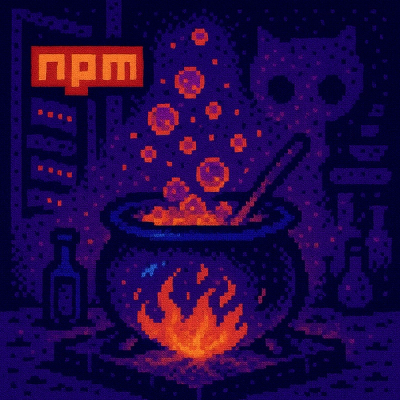
Security News
How Enterprise Security Is Adapting to AI-Accelerated Threats
Socket CTO Ahmad Nassri discusses why supply chain attacks now target developer machines and what AI means for the future of enterprise security.
taskiq-redis
Advanced tools
Taskiq-redis is a plugin for taskiq that adds a new broker and result backend based on redis.
To use this project you must have installed core taskiq library:
pip install taskiq
This project can be installed using pip:
pip install taskiq-redis
Let's see the example with the redis broker and redis async result:
# broker.py
import asyncio
from taskiq_redis import RedisAsyncResultBackend, RedisStreamBroker
result_backend = RedisAsyncResultBackend(
redis_url="redis://localhost:6379",
)
# Or you can use PubSubBroker if you need broadcasting
# Or ListQueueBroker if you don't want acknowledges
broker = RedisStreamBroker(
url="redis://localhost:6379",
).with_result_backend(result_backend)
@broker.task
async def best_task_ever() -> None:
"""Solve all problems in the world."""
await asyncio.sleep(5.5)
print("All problems are solved!")
async def main():
task = await best_task_ever.kiq()
print(await task.wait_result())
if __name__ == "__main__":
asyncio.run(main())
Launch the workers:
taskiq worker broker:broker
Then run the main code:
python3 broker.py
This package contains 6 broker implementations. 3 broker types:
Each of type is implemented for each redis architecture:
Here's a small breakdown of how they differ from eachother.
By default on old redis versions PUBSUB was the way of making redis into a queue. But using PUBSUB means that all messages delivered to all subscribed consumers.
[!WARNING] This broker doesn't support acknowledgements. If during message processing Worker was suddenly killed the message is going to be lost.
This broker creates a list of messages at some key. Adding new tasks will be done
by appending them from the left side using lpush, and taking them from the right side using brpop.
[!WARNING] This broker doesn't support acknowledgements. If during message processing Worker was suddenly killed the message is going to be lost.
Stream brokers use redis stream type to store and fetch messages.
[!TIP] This broker supports acknowledgements and therefore is fine to use in cases when data durability is required.
RedisAsyncResultBackend parameters:
redis_url - url to redis.keep_results - flag to not remove results from Redis after reading.result_ex_time - expire time in seconds (by default - not specified)result_px_time - expire time in milliseconds (by default - not specified)redis.asyncio.BlockingConnectionPool.
Notably, you can use timeout to set custom timeout in seconds for reconnects
(or set it to None to try reconnects indefinitely).[!WARNING] It is highly recommended to use expire time in RedisAsyncResultBackend If you want to add expiration, either
result_ex_timeorresult_px_timemust be set.# First variant redis_async_result = RedisAsyncResultBackend( redis_url="redis://localhost:6379", result_ex_time=1000, ) # Second variant redis_async_result = RedisAsyncResultBackend( redis_url="redis://localhost:6379", result_px_time=1000000, )
You can use this package to add dynamic schedule sources. They are used to store schedules for taskiq scheduler.
The advantage of using schedule sources from this package over default LabelBased source is that you can
dynamically add schedules in it.
We have two types of schedules:
RedisScheduleSourceListRedisScheduleSourceThis source is super simple. It stores all schedules by key {prefix}:{schedule_id}. When scheduler requests
schedules, it retrieves all values from redis that start with a given prefix.
This is very ineficent and should not be used for high-volume schedules. Because if you have 1000 schedules, this scheduler will make at least 20 requests to retrieve them (we use scan and mget to minimize number of calls).
This source holds values in lists.
{prefix}:cron.{prefix}:time:{time} where {time} is actually time where schedules should run.The main advantage of this approach is that we only fetch tasks we need to run at a given time and do not perform any excesive calls to redis.
To migrate from RedisScheduleSource to ListRedisScheduleSource you can define the latter as this:
# broker.py
import asyncio
import datetime
from taskiq import TaskiqScheduler
from taskiq_redis import ListRedisScheduleSource, RedisStreamBroker
from taskiq_redis.schedule_source import RedisScheduleSource
broker = RedisStreamBroker(url="redis://localhost:6379")
old_source = RedisScheduleSource("redis://localhost/1", prefix="prefix1")
array_source = ListRedisScheduleSource(
"redis://localhost/1",
prefix="prefix2",
# To migrate schedules from an old source.
).with_migrate_from(
old_source,
# To delete schedules from an old source.
delete_schedules=True,
)
scheduler = TaskiqScheduler(broker, [array_source])
During startup the scheduler will try to migrate schedules from an old source to a new one. Please be sure to specify different prefixe just to avoid any kind of collision between these two.
Brokers supports dynamic queue names, allowing you to specify different queues when kicking tasks. This is useful for routing tasks to specific queues based on runtime conditions, such as priority levels, tenant isolation, or environment-specific processing.
Simply pass the desired queue name as message's label when kicking a task to override the broker's default queue configuration.
@broker.task(queue_name="low_priority")
async def low_priority_task() -> None:
print("I don't mind waiting a little longer")
FAQs
Redis integration for taskiq
We found that taskiq-redis demonstrated a healthy version release cadence and project activity because the last version was released less than a year ago. It has 0 open source maintainers collaborating on the project.
Did you know?

Socket for GitHub automatically highlights issues in each pull request and monitors the health of all your open source dependencies. Discover the contents of your packages and block harmful activity before you install or update your dependencies.

Security News
Socket CTO Ahmad Nassri discusses why supply chain attacks now target developer machines and what AI means for the future of enterprise security.

Security News
Learn the essential steps every developer should take to stay secure on npm and reduce exposure to supply chain attacks.

Security News
Experts push back on new claims about AI-driven ransomware, warning that hype and sponsored research are distorting how the threat is understood.